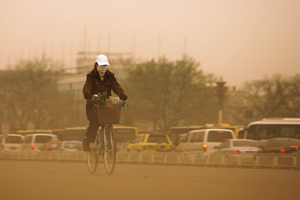
The sand was everywhere, covering the city like dirty talcum powder. It choked, clogged and floated its way into the lives of Beijing residents in a day of madness. Well it had actually been four days of madness. You felt it in your eyes, hair, teeth and worst of all you had to breathe this wind born menace that lingered painfully like unwanted relatives at Christmas time.
On the way to work April 17, even people used to pollution and poor weather were amazed at the sight of cars, trees, buildings and roads redefined in dust and a murky yellow sky giving testimony to the capital's worst sandstorm in years.
The municipal government launched a pollution control scheme hoping to reduce the impact of the dust, sending sprinklers to wash urban roads and instructing construction sites to put the brakes on earthwork. It became a muddy affair. In fact the only people who seemed happy about events were the car washers, which were understandably doing a brisk trade.
I've lived here a couple of years and haven't seen anything like it. Authorities were quick to point out the storm, which lasted from April 15 to 18, was the result of high temperatures, prolonged droughts and cold air.
China has witnessed eight serious bouts of dusty weather so far this year, with three major sandstorms. The statistics were impressive—if you weren't on the receiving end. According to the China Meteorological Administration (CMA), 330,000 tons of sand fell on Beijing during the four days. That's the equivalent of about 820 fully laden jumbo jets. Dust density was recorded at 1,000 micrograms per cubic meter per hour, enough to choke a camel, and for those living in the capital who hadn't noticed, it was the eighth sandstorm in Beijing this year.
An official from the municipal environment protection bureau explained that the size of sand particles in the storm were measured at 100 microns in diameter, a lot bigger than the general pollution particles of 10 microns. Kind of like the equivalent of dust hailstones dropping down. He also said that the city's air quality peaked at level V or hazardous. I was wondering if the V had anything to do with victims.
Forecasters said the sandstorms originate from places outside Beijing and even outside China, generally the deserts of Inner Mongolia, although the thousands of construction sites in the capital add to the problem. It seems as if the problem is an imported one—and it's evading customs and immigration along the way.
Like everyone else who calls Beijing home, every poor weather day has me wondering, "What happens if these sandstorms blow away the Olympics?" You can bet Liu Xiang is not going to sprint to a world class hurdle time if he is running with an oxygen tank on his back and covered in face masks.
The Chinese Government remains optimistic that in spite of the frequent sandstorms that torment Beijing the 2008 Summer Olympic Games will still be a "Green Olympics".
Liu Tuo, head of the desertification prevention and treatment department under the State Forestry Administration (SFA), said, "China will intensify its afforestation efforts in and around Beijing to create a better environment for the Olympic Games."
After an afforestation project in several sand-prone areas (Inner Mongolia) was launched in 2001 to tackle the sandstorms, the coverage of forests and grass in those areas increased by an average 30 percent, said Liu.
"It's high time for the forests and grasslands to play their roles in the 2008 Olympic Games. What's more, the Olympic Games is scheduled in August, when sandstorms seldom happen in Beijing," Liu said.
That's comforting to know.
Going home that evening, safely ensconced in the back of a taxi, I watched as cyclists and pedestrians leaned into the wind and sand, heads wrapped in scarves, towels and jackets. White fluffy pollen particles from the Aspen trees that line city streets were now raining down, seemingly also wanting to get in on the act of upping the allergy ante. It was pollution deluxe and I said a prayer for every afforestation project everywhere to help us out of our misery.
From January 1 to April 17, Beijing has reported 56 "blue sky days." As an artist there is one thing I have learned and that is there are very many different shades of blue. Then again, I guess blue is in the eye of the beholder.
The author is a South African living in Beijing.
| 